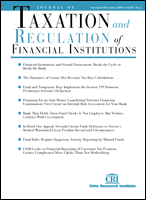Addressing Controls and Containing the Costs of Sarbanes- Oxley Using Contemporary Technology
Author: Greg Prow.
Source: Volume 19, Number 03, January/February 2006 , pp.19-23(5)

< previous article |next article > |return to table of contents
Abstract:
For most companies, the most time-consuming and costly requirements of complying with the Sarbanes-Oxley Act are those that are related to internal controls. Essentially, Sarbanes-Oxley mandates that company management establish and maintain an adequate internal control structure and assess the effectiveness of that structure each year. Additionally the public auditor must also assess the adequacy of those controls each year. For tax, Sarbanes-Oxley has affected a range of processes including reserves, compliance management, inter-company transactions, data and document retention, tax provision and valuation allowances. But for all its positive intentions directed to shareholders, ensuring effective internal controls have proven to be one of the most difficult and expensive tasks for companies. Once implemented, software serves as a guardrail, enabling best practices to be repeated, ensuring process sustainability, and enabling quality control. In order to be effective, this guardrail must evolve and adapt as the business flow changes.Keywords:
Affiliations:
1: Planitax.